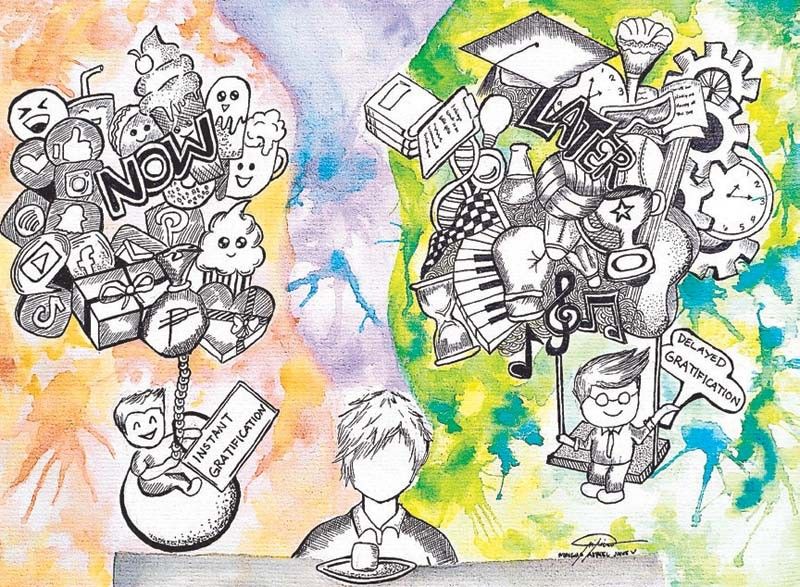Teaching Gen Z

Amid a generation where many subscribe to instant gratification, what does it mean to be a college teacher to Gen Z?
It means getting in a tussle to make them understand that the world was not created just for them. It means making them realize that instant gratification is fleeting, that everything cannot be learned in just a click of the mouse or a scroll on their cellphones, though technology aids in making lessons swift.
In “Understanding the Self,” a subject I teach at St. Vincent’s College of Cabuyao, a private community college, I tell my students, all belonging to Gen Z, a generation born between 1997 and 2010, that delayed gratification has its own merits; that those who labor hard enough and wait for the fruition of their dreams develop emotional intelligence that cannot be equaled by their intelligence quotient.
I mentioned the Marshmallow Test of my generation and it was mostly received with awe. But I stubbornly taught them that delayed gratification, like self-control and self-regulation (particularly in using social media), have rewards.
For this semester, I handle 16 sections (in “Understanding the Self,” “Philippine Pop Culture” and “Art Appreciation” subjects) populated by more than 700 students. Some 90 percent of my students are hard-up. Reasons for their non-attendance in class include lack of money for their transportation. Some, however, are enterprising. One lady student attended my class with a bag filled with boiled peanuts wrapped in cellophane — they don’t know that word — in one hand and her four-year-old son in another.
“No one is at home to take care of my son so I brought him with me,” she said. My soft spot prevailed so I gave her well-behaved son an extra chair beside his mother while distributing all the peanuts to my students. “Keep the change,” I said when I handed her the payment. She cried out of gratitude. The change was P50. That’s already a big amount for her. Bigger were her dreams.
When face-to-face classes became fully available last semester, I had a stark realization that students excel more in exam formats other than the traditional test paper. The multiple-choice type of exam where all the choices seem correct but only one is the best answer did not work as 98 percent failed my “Philippine Pop Culture” preliminary exam.
I allowed a retake. But this time without pen and paper. I introduced focus group discussion (FGD) to my students — something that employed people do. I simplified it by asking them to elect a leader who would moderate the group. “All opinions matter and every member of the group is required to have an opinion. Otherwise, no grade,” I said.
More than anything else, it’s critical thinking and creative execution of their thoughts that I highlight in my class. After all opinions were gathered in the FGD, I asked each group to present to class. The options for presentation were the following: a normal report, though I discouraged it because it had the tendency to be boring; a presentation of a skit where their thoughts became dialogues and they got to display the thespians within them; a musical presentation where they would create original songs out of their thoughts. I gave them more than an hour to process their thoughts and after that, one group came back to class shirtless and aped a scene in Batch ’81 to discuss their own take about the perilous hazing journey of those who joined a fraternity. Yes, I always use film as a medium of instruction. The school provided me with a huge TV set and a good sound system.
Still on the subject of FGD, two sections in my “Understanding the Self” class of Criminology students opted to take their preliminary exam paperless and pen-less because they could better express their thoughts on the film Respeto, starring Abra, the rapper of their generation, through another form. They did a flip-tap battle for their exam, where rapping was the medium and beatboxers provided the background melody. My students did their rap exam so well. There was poetry, angst and resolution in their performances so I gave them the highest grade for their exam. It was a bonus that I did my own rap before I dismissed the class.
Teaching Gen Z means developing student-centered learning where their excellence can be harnessed more. They get to learn more and better when lessons are done the way their generation understands it. The old “banking” method of teaching, where all information is taught to them, dumped like blocks of information without fully knowing whether the students learn or not, does not work anymore. Art is involved in teaching. And, in my case, art means being creative in the room. The teacher is an actor. His stage is the classroom. The students are the audience who need to have a takeaway from the lessons of the day.
Teaching is theater arts, indeed. One day, I arrived so much earlier than my usual and found students outside my classroom who obviously arrived earlier than me. One had a guitar. They egged me on to sing with them as we waited for the school property custodian to open the room. I performed Darna, a song of Kamikaze, a band that this generation is all too familiar with. That performance gave impetus for me that day to discuss why Mars Ravelo created the Pinoy superhero Darna — the information I gave them was based on my term paper in college in the late ‘80s and from my interview with the relatives of Mars Ravelo, who died in 1988. The discussion of Darna in my Pop Culture class was so electrifying as students gave their thoughts — “Superheroes are created because we need them to help our insecure selves,” “We need superheroes because being weak is a nature of man,” “We need superheroes to make our faith more firm, because superheroes possess the qualities of God.” I was floored.
Last year, when I discussed Darna as part of Philippine Pop Culture in an online class for Business Administration students, Marian Rivera popped up in my class, with Dingdong Dantes doing a cameo because he was setting up the computer for his beautiful wife. My students were thrilled. They learned more about Darna from Marian herself, who starred in GMA’s teleserye rendition of Darna.
In another occasion when I discussed why students needed to watch and analyze quality films and not just be glued to bubble-gummy and glossy flicks of big production houses, young superstar Judy Ann Santos appeared in my class for three hours. They learned the deeper discussion of Juday’s movie Ploning from her and her life when she still did not have a car, getting shouted at on a set when she came late because, yes, she had to take public transportation to Laguna. “It doesn’t matter how you start — whether it is easy or hard. You just need to start. And show up,” Juday told the class.
I always show up in class — rain or shine, with or without the threat of vog from the distant Taal Volcano. Even if it means teaching the Gen Z from 8 a.m. to 8 p.m. Mondays and Tuesdays. I always show up in class.
Like next Monday, I already have a lullaby in mind when I discuss “overthinking,” among the Gen Z in my Understanding the Self class — where students will bring sleeping bags, pillows and blankets in my class because I will ask them to sleep for two hours to quiet their minds. And then we discuss.
(For your new beginnings, e-mail me at [email protected]. I’m also on Twitter @bum_tenorio and Instagram @bumtenorio. Have a blessed weekend.)
- Latest




























